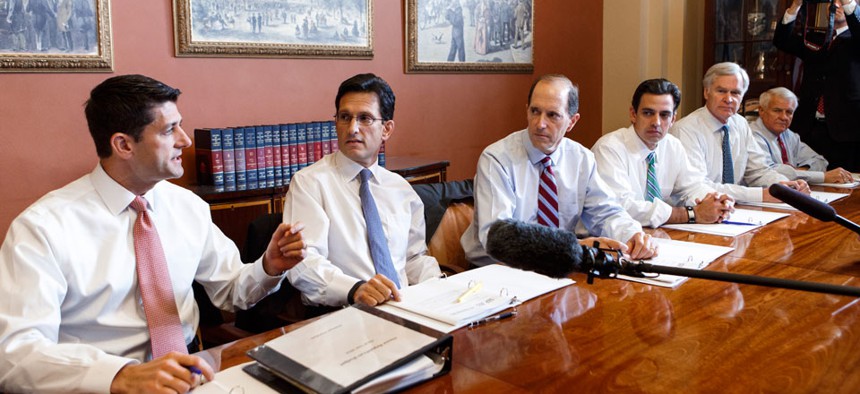
House Budget Committee Chairman Paul Ryan, R-Wis., House Majority Leader Eric Cantor, R-Va., House Ways and Means Committee Chairman Dave Camp , R-Mich., and Rep. Tom Graves, R-Ga., talk briefly to reporters Oct. 1. J. Scott Applewhite/AP
Why the House GOP Lacks an Electoral Incentive to Compromise
Even if Republicans behave badly in the budget and debt-ceiling fights, they face little risk of losing House control.
Could Republicans lose their House majority if the budget showdown and the upcoming debt-ceiling fight go badly for them? Anything can happen, of course, and the polls showing that Republicans are likely to catch more of the blame than President Obama for Washington's dysfunction are making some Democrats more optimistic about their prospects of regaining control. Still, the odds of a Democratic takeover of the chamber are slim.
Even though the gap between Republicans and Democrats in the House is only 17 seats, it would take a pretty big wave to get Democrats up to 218. We have seen waves before: 1980, 1994, 2006, and 2010 come quickly to mind. But, then again, the party holding the White House was on the losing side in each of those tidal-wave elections. A Democratic takeover would require a huge wave running against the party not in the White House, something that hasn't happened since Franklin Roosevelt's first few years in office.
How bad would things have to get for the GOP to lose its majority? One answer is to look at where each of the 435 House races stand today. Democrats would have to win 100 percent of the 192 races The Cook Political Report now rates as Solid-, Likely-, and Lean-Democratic, plus all of the 10 races in the Toss-Up column, all of the 11 races in the Lean-Republican column, and five (29 percent) of the 17 rated as Likely-Republican. Needless to say, that is a very tall order.
Stuart Rothenberg and Nathan Gonzales use somewhat different rating categories in The Rothenberg Political Report, but their numbers suggest essentially the same challenge for Democrats. In their Sept. 27 edition, they rate 211 Republicans seats as "Currently Safe," just seven short of locking up a majority. Democrats would have to win all 175 races that the Rothenberg newsletter rates as currently safe for Democrats, all 18 that it calls "Lean/Favored" for Democrats, all of the 14 Toss-Up races, and 11 of 17 of the Lean/ Favored Republican seats.
In a tsunami year, you can certainly count on seats falling that virtually no one expected. In the 1994 wave that handed House control to the GOP for the first time in 40 years and made Newt Gingrich the speaker, Republicans needed 40 seats to get a majority. No objective analyst thought that was a realistic possibility. With Hamburger Helper, you could imagine gains in the low 30s if you gave every conceivable race to the Republicans—but not 40. Only the Kool-Aid drinkers who predicted GOP majorities in virtually every election were predicting that in 1994; I certainly didn't think it could happen. (My late mother saved a USA Today clip quoting me as giving Republicans a one-in-three chance of taking the House; I wish I could recall saying that, but I really don't remember.) But, again, these waves almost always hit the White House party, not the opposition. Even in the Clinton-impeachment-backfire election of 1998, GOP losses were minimal.
A different approach is to look at how much the national vote for the House would have to shift to yield the 218 seats the Democrats need for a majority. David Wasserman, the House editor for The Cook Political Report, recently crunched the numbers in a spreadsheet of all 435 House results from 2012. Last year, with Obama at the top of the ticket beating Mitt Romney by just under 4 percentage points, Democrats carried the popular vote for the House by 49.16 percent to 48.03 percent, a shade above 1 percentage point. Looking at the margins in each district, Wasserman calculates that Democrats would need to win the total House vote nationally by at least 6.8 percentage points to take 218 seats next year. It would require one heckuva tailwind for Democrats to run up that kind of popular-vote margin, something unprecedented in modern midterm history for the party holding the White House.
Moving to the subject of the shelf life of a budget fight gone bad, an Oct. 1 analysis by the Gallup Organization's Elizabeth Mendes looked at Gallup's approval and favorability ratings, among other poll numbers, immediately before the 1995-96 government shutdowns, just after them, and then several months later. Both President Clinton and Gingrich saw their numbers dive immediately after the shutdowns, but then they bounced back completely or within a digit or two. The current budget and debt-ceiling showdowns are occurring more than a year before the midterm elections; it seems unlikely they'll have the staying power to affect approval ratings that far in the future. Other events between now and Election Day are likely to shift the numbers around.
Obviously, nobody knows what will happen with the current fights over the budget and the debt ceiling. Could they change the landscape sufficiently to create a huge and unprecedented wave for the president's party in 2014—a wave that could swing that many districts and shift the national vote that much? Sure, anything's possible. And I suppose I could be thin by Christmas. But I wouldn't bet on either.






